Climate Loss and Damage from Big Oil + Lyme Disease Risk in City Parks
Published: June 15, 2020
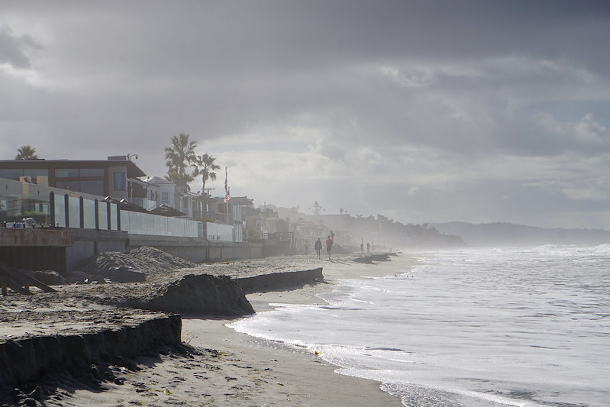
Sea level rise is threatening homes, businesses and infrastructure along California’s coast. (Photo: Emmett Institute, Flickr CC BY-NC 2.0)
(stream/download) as an MP3 file
Several coastal counties and cities in California are suing Big Oil to seek compensation for the steep costs of adapting to sea level rise. Now the litigation is one step closer to trial.
Also, people in cities have been relying on parks for a dose of fresh air during the pandemic, but lurking in the leaf litter and elsewhere in the park might be the tiny ticks infected with the bacteria that causes Lyme disease.
CURWOOD: Hi, I’m Steve Curwood and today on the Living on Earth Podcast we’ll take a look at the California lawsuits against dozens of oil companies for loss and damage from climate change.
And we’ll hear about the risk of Lyme Disease from ticks in city parks.
But first, your support helps make it possible to bring you this podcast, so please contribute what you can.
Five dollars or more makes a difference.
You can donate right now at LOE.org and thanks!
[THEME]
CURWOOD: Back in 2017 Marin and San Mateo counties and the City of Imperial Beach in California sued 37 fossil fuel companies and trade groups.
They claimed the defendants knew about the threats posed by burning fossil fuels years ago.
And now, as seas rise on the California coast, and adaptation costs loom, these communities want them to pay damages.
A bit later in the podcast we’ll have an update to that story but first let’s take a listen to the 2017 discussion with Columbia law professor Michael Burger which lays out the details of the case.
BURGER: What these local governments are claiming is that these fuel companies have known for many years about the consequences of the use of their fossil fuel products, particularly that use of these products would contribute to climate change and cause any number of damages, including damages resulting from sea level rise, and so they are seeking to have these companies pay for a number of different types of costs, including the costs of adaptation to climate impacts from sea level rise, as well as costs associated even with studying the issue, planning to address the issue, development of adaptation plans, and then implementation of those plans as well.
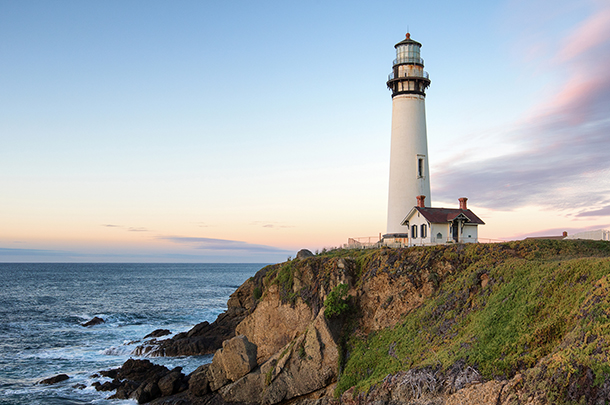
Pigeon Point Lighthouse in San Mateo County is one of the most iconic on the California Coast. (Photo: Frank Schulenburg, Flickr CC BY-SA 2.0)
CURWOOD: So, be more specific for me about the kinds of climate impacts that the citizens of these counties have already been affected by and possible costs associated with them.
BURGER: The basic claim here is that, as sea levels rise, coastal property is lost -- It is literally inundated -- That homes are at increased risk of severe storms and flooding from extreme precipitation events, and that critical infrastructure has also, has already been impacted and is at risk of increased impacts. So, we're talking about roads, bridges, hospitals, and all kinds of infrastructure that make up the communities within these counties and city.
CURWOOD: Now, at the heart of these claims is the idea that companies are infringing on the public nuisance doctrine. What is nuisance law, and how might these companies be breaking these laws, or not?
BURGER: Basically, the idea of the public nuisance doctrine is that there are certain resources and rights to health and well-being that are held in common by the public, and that private actors can infringe upon those rights and create a nuisance that is not just a nuisance to you or me as a homeowner or a property owner or a person with our own bodies, but that, in fact, they're causing harms to goods that are possessed by all of the members of the state.
CURWOOD: What precedent exists for these cases?
BURGER: So, this is not the first time that we've seen common law claims brought around climate change. Back in 2005, a number of states and cities as well as some environmental organizations and land trusts claimed that five power companies, the five largest power companies in the United States, should be held liable for the public nuisance of climate change. And that case, which was known as Connecticut versus American Electric Power, eventually made its way all the way up to Supreme Court, where the Supreme Court said that the common law claims were preempted, that they were displaced by the Clean Air Act, that since Congress had acted on this already, there was no further room for the courts to act.
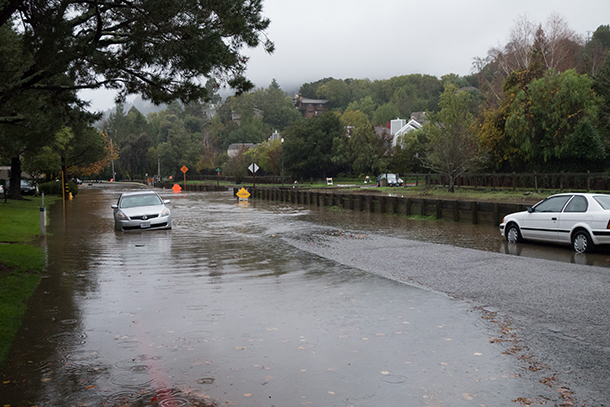
Flooding in Larkspur in Marin County, a plaintiff in a climate loss and damage lawsuit three California localities have brought against a number of fossil fuel companies. (Photo: Jesse Wagstaff, Flickr CC BY 2.0)
But importantly, what that case was talking about was a federal common law claim of public nuisance. These lawsuits allege state common law claims, and we have not yet had any final decision or really any court address the issue of whether state common law claims can survive.
CURWOOD: Now, some are comparing these lawsuits to litigation that took down the tobacco industry in the 1990s. How accurate might that comparison be?
BURGER: Well, there certainly are similarities. You know, I guess I'll start off actually by talking about what the key differences is.
In the tobacco case, you had companies that were manufacturing a product that was directly consumed by an individual and that direct consumption led to cancer and other health problems. Here, you have fossil fuel companies who are -- In this lawsuit, they're largely extraction and production companies, so they're pulling the fossil fuels out of the ground and preparing them for the market and sending them. But eventually, there are other consumers who are combusting those fossil fuels, and that includes you and me, and so you basically have a much longer chain of causation between what these companies have done and the harms that are being claimed and what the tobacco companies did and the harms that were claimed in those cases.
Now, that being said, there's a very key similarity here, which is, like the tobacco litigation in the 1990s, these lawsuits rely on a long history of corporate knowledge and obfuscation to make their claims. Basically, what the plaintiffs here are saying -- What these counties and cities are saying -- is that the fossil fuel industry knew that this was going to cause climate change. They hid that fact as much as they could. They lied about it. They paid others to lie about it, and they've been holding on as long as they can to their existing business models, and as a consequence they should pay for the damages.
CURWOOD: How does that assertion work under common law? If you say that somebody is making and selling a product that they know is bad, is going to cause harm, and not telling the public about those possible consequences, how vulnerable are they under this standard of common law?
BURGER: I mean, it remains to be seen. It's quite possible that these cases will be dismissed immediately for any number of different reasons. The courts could find that this is a political question, that climate change is really a political question that ought to be resolved by Congress and the Executive Branch and that courts shouldn't be deciding these types of cases. They might say that it's just impossible ultimately to prove causation. They might say that federal laws have preempted. These companies were extracting fossil fuels under license from the federal government when they were doing it within the United States and in most, if not all, circumstances with permits and licenses from other governments, foreign governments, when they were doing it abroad. So, it is certainly feasible that these cases will disappear fairly quickly.

Michael Burger is the Executive Director of the Sabin Center for Climate Change Law. (Photo: Columbia University)
That said, we're in a much different place than we were five years ago. The knowledge about how long these companies have known about climate change, what they did to obscure the public debate about climate change, is much more well-grounded than it was even back then. In addition, the science is much more advanced, and the science of attribution, in particular, is much more advanced. So, there are a number of different methodologies that scientists and experts can now rely on to say, well, we can attribute a certain quantity of greenhouse gas emissions to these particular actors. We can say these fossil fuel companies are ultimately responsible for this quantity of emissions. They can also say that this quantity of emissions has had this much of an impact on global warming and global climate change, and then, they can even say that this amount of global warming and global climate change has contributed X amount to the increased risk of sea level rise impacts in these particular communities. None of those are a slam-dunk, but the plaintiffs are in a much better place to rely on the existing science to support their claims.
CURWOOD: I would imagine that if one iota of responsibility is found by the courts there, that even if it's half a percent of the damages, those numbers are huge.
BURGER: Ultimately, they can be huge, especially if we start to see these types of lawsuits pop up, not just in these particular communities in California but other communities in California, and other communities all around the United States.
You know, I think that this lawsuit, these lawsuits are of a type of lawsuit that those of us in the field have been waiting a long time for. We've been wondering when these public nuisance state common law claims would be brought. And here they are.
CURWOOD: Michael Burger is Executive Director of the Sabin Center for Climate Change Law at Columbia University. Thanks so much for taking the time with us, Professor.
BURGER: Thank you, Steve.
CURWOOD: Billions of dollars are at stake in the California climate cases.
And the oil companies wanted the cases tried in federal court, but now the U.S. Circuit Court of Appeals for the Ninth District has sent the litigation to California state courts, where if the cases are proven, state law allows juries to make major awards for damage.
But wait.
There are similar cases in other jurisdictions so before it is all over the US Supreme Court may get involved.
Here to explain is Vermont Law School Professor Pat Parenteau.
Pat, welcome back to Living on Earth!
PARENTEAU: Thanks, Steve. Very good to be with you.
CURWOOD: And just to be clear, on the record, you've given some pro bono advice to some of these plaintiffs here.
PARENTEAU: That's correct. Pro bono, for free.
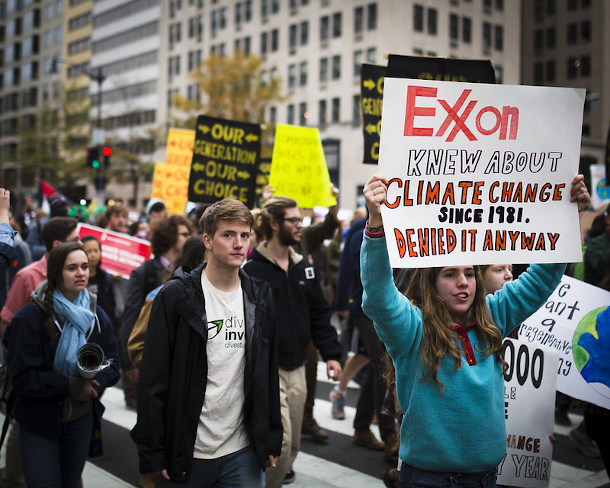
A protester carries a sign calling out fossil fuel giant Exxon for quietly studying climate change decades ago, while downplaying the risks publicly. (Photo: Johnny Silvercloud, Flickr CC BY-SA 2.0)
CURWOOD: What exactly is the argument that the California cities and counties are making? Why do they say that these fossil fuel companies should be on the hook for paying for some of the costs of dealing with climate impacts?
PARENTEAU: Right, and the impacts they're talking about are real. They're focused on the coastal zone of California. They're focused on sea level rise, storm surge, flooding, coastal erosion. They have the science behind them to say that what's happening to California's coast is the result of climate change and carbon pollution of the atmosphere. And they're saying that these defendants are the major contributors to the atmospheric pollution that's causing this damage, and the counties and cities are having to expend significant amounts of money to try to armor plate the coastline against these changes, or to move facilities out of the danger zones, the high hazard zones, all of which costs lots of money, causes lots of disruption. And they're saying all of this lies at the feet of the oil industry, because they knew this was coming. They knew it was going to be significant. They didn't warn anybody about it. They tried to cover it up; many times, they were successful in covering it up. Had they not done that, steps could have been taken long ago to either address the emissions that are causing this problem, or at least get started on adaptation planning. That's the nature of the damages they're seeking; they're actual costs, they're not hypothetical numbers. And also the conduct of the defendants, which is now almost a matter of public record. There's been so many of the documents now have come to light that prove what the companies knew and how they dealt with the knowledge. So it's a really classic tort case, where it's the conduct of the defendants that's the real issue as much as anything.
CURWOOD: In other words, the oil companies knew about the problems of greenhouse gases, and yet did not take action and in fact, misled the public? How important is that to the case?
PARENTEAU: I think that's very important. It is an act of misleading and lying, not to put too fine a point on it, about what you did know, and what you did about it. And there's a very strong line of cases in California, some of the precedents deal with lead paint, for example. California sued the paint manufacturer Sherwin-Williams and others and said, you actually knew that lead paint was going to create hazards as the paint weathered, and as it came off the walls inside of homes or on the outside of homes, and as children began playing in these areas, and ingesting this lead, and doing serious damage to their brains. This was all information you had, decades ago, and you, you hid it from the public. And you told mothers to paint their nurseries because lead was durable, and it was easy to clean. Instead of saying, you know what, at some point this lead is going to get out of the paint and onto the floor and expose your kids to it, and that's going to be dangerous. They didn't do that. So California won a huge damage award against the paint manufacturers, over a billion dollars to go in and de-lead these various residences that have a high level of, of leaded paint in them. So that's a key precedent, actually, for these climate cases, because it's the same kind of behavior of companies selling a product, knowing it's dangerous, and not disclosing that.
CURWOOD: Pat. Let's say that, for whatever reason, you decided to represent the oil companies. What would you be most worried about in these cases, if you were representing them?

The runways of San Francisco Airport are just 10 feet above current sea level. (Photo: Nathan Rupert, Flickr CC BY-NC-ND 2.0)
PARENTEAU: The first thing I'm going to be worried about is the discovery process in these cases, which is open now, the plaintiffs can proceed to call some of these corporate executives and put them under oath in a deposition and start asking them very specific questions and showing them documents and saying, "As far back as the 1960s, even, you began studying these problems, and you knew, right?" And so you're going to ask these people questions about what they knew, when they knew it, what they did with it, why they didn't disclose it. Did they fund active anti-legislative movements to prevent Congress from adopting, for example, the Waxman-Markey law, which would have created a cap and trade program for dealing with carbon emissions decades ago? And they're gonna have to answer those questions, the same way that tobacco executives ultimately had to answer questions or face even more serious repercussions from perjury. So that's one thing that the industry is very afraid of, is actually having on the record to admit what they've done. The other thing is, the reason the states want to be in state court, is because they rightly think they're going to have a more sympathetic jury pool to draw from. State court juries are different than the way federal juries are composed. It does give the states an upper hand. And of course, in the end, it's what the jury decides that matters. So that's what the industry is worried about: case gets to a jury after this lengthy discovery, in which all of their, chicanery, if you will, has been revealed, and they're looking at some huge verdicts.
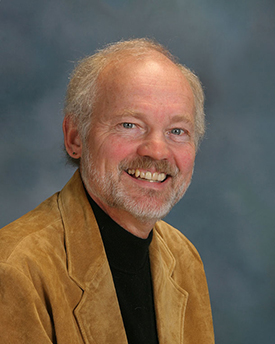
Former EPA Regional Counsel Pat Parenteau teaches environmental law at Vermont Law School (Photo: Courtesy of Vermont Law School)
CURWOOD: Hmm. So if these counties and towns should prevail, how much money do you think that the fossil fuel companies could be on the hook for?
PARENTEAU: Well, it's billions, that's for sure. You have to start thinking about the damage that's already been done to the California coast, and what's coming. For example, San Francisco is seriously contemplating having to move the airport. Anybody who's flown into San Francisco knows where that airport is. And if you look at the models of sea level rise that are affecting the California coast, that's a very, very difficult location to maintain an airport. I mean, the kind of sea walls that you would have to build to protect it are, you know, phenomenally expensive. So that's the kind of thing where the amount of damages are going to be very hard to quantify and estimate. And it may be that some of these cases don't result in a one-time damage award, they may be ongoing. And obviously, the extent to which we get a handle on some of these emissions and begin to really bring them down to the point where some of these worst case impacts aren't realized, that's going to be all the more important. That's another role for these court decisions, obviously, is to push the politics of climate hard, and to push the industry hard. And it's also going to be reflected in the financial markets, which are becoming more and more nervous about investments in all of this fossil fuel infrastructure, and extraction of all these sources of oil and gas all over the world. And we're seeing, you know, brokers like BlackRock pulling away from fossil investment, JP Morgan, issuing warnings to some of their companies that they loan money to, that's one of the biggest financiers of fossil fuel development in the world. You're really seeing movements in everywhere except the United States Congress, frankly, on this issue. And these cases are propelling that.
CURWOOD: Pat Parenteau is a Professor of environmental law at the Vermont Law School. Pat, thanks so much for taking the time with us again.
PARENTEAU: My pleasure, Steve, thank you.
[MUSIC]
CURWOOD: Please join us for the next live Living on Earth Good Reads on Earth event. We will be speaking with award-winning biologist and author Carl Safina about his latest book Becoming Wild: How Animal Cultures Raise Families, Create Beauty, and Achieve Peace. It's a provocative exploration of the complex communities that exist among sperm whales, scarlet macaws, and chimpanzees. You can be part of the conversation online via Zoom or Facebook, and please ask questions, if you like. That’s Monday, June 22nd at 7 PM Eastern. Details are available at loe.org. Just click on the events tab at the top of the page.
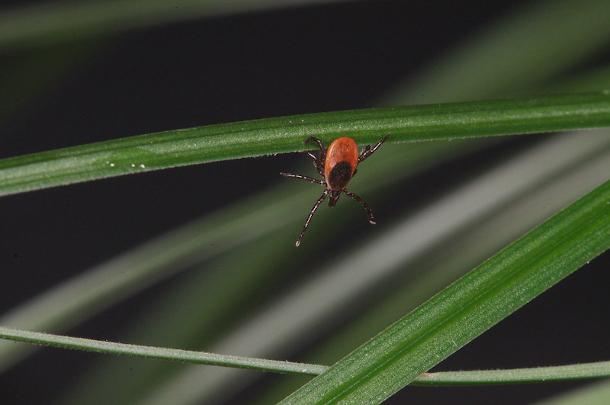
A female blacklegged tick reaches out her forelegs in search of a blood meal. (Photo: James L. Occi / Armed Forces Pest Management Board, Flickr CC BY-NC-ND 2.0)
CURWOOD: You might be thinking it’s perfectly safe to head out to a park to get some fresh air during the pandemic but be careful. Lurking in the leaf litter and elsewhere in the park might be the tiny ticks that carry Lyme disease. Kara Holsopple from The Allegheny Front has the story.
HOLSOPPLE: Thomas Simmons and his biology students from Indiana University of Pennsylvania, collected black legged tick samples from random sites in four of the large Pittsburgh parks in 2015 and 2016, including Schenely Park
SIMMONS: This is Prospect Hill, a hotspot.
HOLSOPPLE: The trail is shaded by trees on either side and Simmons drags a one meter square of white heavy flannel material along the edge of the path.
SIMMONS: I'm going to veer off a little bit into the woods, get off of the pavement and the gravel here.
HOLSOPPLE: The idea is that the ticks stick to the flannel which is about the size of a beach towel as it's pulled along the ground. In a few weeks it will be the peak of nymphs season that's the stage between the larval tick and an adult. And a bite from a nymph is how most cases of Lyme disease are contracted someone sets.
SIMMONS: They're attracted to vibrations, heat, shadows. I mean they are well equipped to find the host. It’s like a heat seeking erected really.
HOLSOPPLE: After about 10 steps, he carefully checks the fabric.
SIMMONS: Oh, there's one right there. Oh, my goodness. So take a look that's small.
HOLSOPPLE: It's the size of a poppy seed. Simmons and his team also set up stations within the woods where nymphs prefer the cooler moist habitat. The study about infected ticks in the parks was published online in the Journal of Medical Entomology last September.
So what did you find?
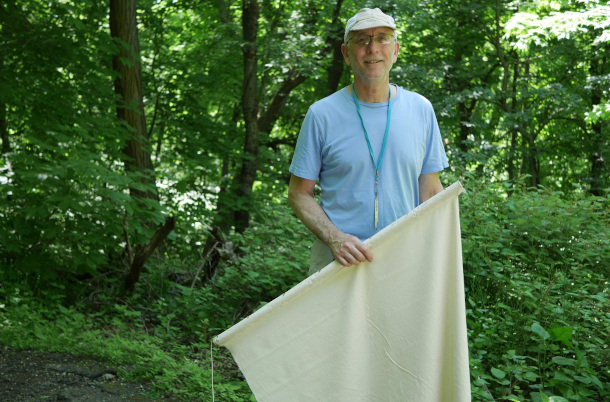
Thomas Simmons and his team used flannel “drags” to sweep over vegetation at the edge of trails and wooded areas to find and collect blacklegged ticks for the study. (Photo: Kara Holsopple / The Allegheny Front)
SIMMONS: So overall, for all the parks 50% of the adult ticks were infected. And 20% of the nymphs, we call that infection prevalence and those infection prevalence’s are characteristic of a region which is highly endemic for Lyme disease, which Western Pennsylvania now is and those present infection rates are comparable to what has historically and presently is found in Southeastern New York where we typically use that as kind of I don't say worst case scenario, but but as a good comparison to determine how bad I can use the word bad. But how much concern there is or how high the Lyme disease risk is probably a better way to put it.
HOLSOPPLE: Though the risk is high?
SIMMONS: So the risk is high. Also, not only is it important in terms of what percent of the ticks are infected, but it's important to know what the density the abundance of the density of the ticks are. Because what really determines Lyme disease risk is the the numbers of infected ticks, and the density of infected nymphs and the density of infected adults in these parks is also comparable to the East Coast. I should also note that not every infected tick infects. So that's important to realize that these are really high rates 50% of adults are infected, you might think, Oh my goodness. 50% if I'm bitten by a tick, adult tick, I have 50 % chance of being affected or if I'm bitten by a nymph, I have 20% chance of being affected. No, not every infected tick.
HOLSOPPLE: Simmons estimates the tick density in Pittsburgh parks is about one tick per two square yards. He says the study findings certainly don't mean people shouldn't use the parks, but just take precautions. his advice to avoid being bitten by a tick is to stay to the center of trails. Wear light colored clothing so you can see the ticks clinging to your clothes and tuck long pants into socks. You can also treat your clothing with a chemical insecticide or essential oils. When you go home, toss your clothes into a hot dryer for 10 minutes.
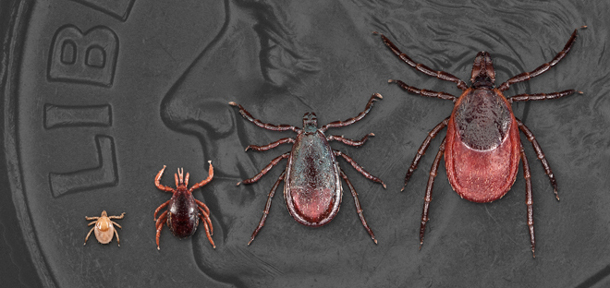
From left, the larvae, nymph, adult male and adult female forms of the blacklegged or deer tick, which can carry Lyme disease. (Photo: CDC)
SIMMONS: That day, that night, definitely take a shower and check every part of your body and then some.
HOLSOPPLE: Simon says a nympho feel like a little bump or pimple. So what is the significance of what you found for Pittsburgh and also for urban areas where they have you know, Parks like this.
SIMMONS: So I think the take home message is that when you use a park By all means, do this is a good thing during this pandemic, especially, you know, you got to get out and getting exercise anytime a year is really important. And it's just, it's healthy. It's it's, it's just good for you. However, like anything else, there's risks, there's risks of crossing a street, there's risks of riding a bicycle. So not only is it useful, important for any Pittsburghers to know that there is Lyme disease risk, and they should take precautions as they should in rural suburban parks and in their backyards. But it's sort of a wake up call and and emphasizes the importance of looking at tick borne disease risk of Lyme disease risk in city parks in any place in the country.
HOLSOPPLE: What can be done by parks or people who manage these types of spaces to manage ticks? Is there anything that you can do to minimize tick exposure for for people who are using the parks?
SIMMONS: Basically, ticks and Lyme disease and other tick borne diseases? They're here to stay? We do not have a vaccine yet. So it's all about prevention. But also parks can take preventative measures, and that's basically education, Lyme disease awareness signs. Just like now with COVID-19, what do you see? Social distancing signs. We should be doing the same thing for tic signs in areas that I think well, I think every entrance should be posted, but at the minimum areas that have a high numbers like here. Also, and I think it's at least my experience going through all these parks is that the trails that most people use are well managed. Right, the trail we are on doesn't have vegetation and grass growing out into it. Right, we're we're walking on part dirt gravel as you saw, you could still pick up nymphs there, but we'd pick up a lot more if I was dragging through the leaf litter believe me. As long should be kept short, trails should be kept clear and the edges should be manicured.
HOLSOPPLE: Thomas Simmons is a biology professor at Indiana University of Pennsylvania. For Living on Earth I'm Kara Holsopple.
CURWOOD: Kara Holsopple’s story comes to us courtesy of The Allegheny Front.
[MUSIC]
CURWOOD: Living on Earth is produced by the World Media Foundation.
Our crew includes Naomi Arenberg, Paloma Beltran, Bobby Bascomb, Thurston Briscoe, Jenni Doering, Jay Feinstein, Anne Flaherty, Don Lyman, Isaac Merson, Aynsley O’Neill, Jake Rego, Kori Suzuki, and Jolanda Omari.
Tom Tiger engineered our show.
Alison Lirish Dean composed our themes.
You can hear us anytime at L-O-E dot org, Apple Podcasts and Google Podcasts- and like us, please, on our Facebook page - Living on Earth.
we tweet from @livingonearth. And find us on Instagram at livingonearthradio.
I’m Steve Curwood
Thanks for listening!
ANNOUNCER: Support for Living on Earth comes from Sailors for the Sea and Oceana. Helping boaters race clean, sail green and protect the seas they love. More information at sailors for the sea dot org.
ANNOUNCER 2: PRX.
Links
Read the 9th Circuit opinion in the San Mateo et al. case
The 9th Circuit opinion in the City of Oakland et al. case
The tick story on The Allegheny Front | “Lyme Disease Risk Is High in City Parks, Too”
CDC | Learn more about ticks and tickborne diseases
Listen to our story on the idea of using guinea fowl for backyard tick control
Living on Earth wants to hear from you!
Living on Earth
62 Calef Highway, Suite 212
Lee, NH 03861
Telephone: 617-287-4121
E-mail: comments@loe.org
Newsletter [Click here]
Donate to Living on Earth!
Living on Earth is an independent media program and relies entirely on contributions from listeners and institutions supporting public service. Please donate now to preserve an independent environmental voice.
NewsletterLiving on Earth offers a weekly delivery of the show's rundown to your mailbox. Sign up for our newsletter today!
 Sailors For The Sea: Be the change you want to sea.
Sailors For The Sea: Be the change you want to sea.
 The Grantham Foundation for the Protection of the Environment: Committed to protecting and improving the health of the global environment.
The Grantham Foundation for the Protection of the Environment: Committed to protecting and improving the health of the global environment.
 Contribute to Living on Earth and receive, as our gift to you, an archival print of one of Mark Seth Lender's extraordinary wildlife photographs. Follow the link to see Mark's current collection of photographs.
Contribute to Living on Earth and receive, as our gift to you, an archival print of one of Mark Seth Lender's extraordinary wildlife photographs. Follow the link to see Mark's current collection of photographs.
 Buy a signed copy of Mark Seth Lender's book Smeagull the Seagull & support Living on Earth
Buy a signed copy of Mark Seth Lender's book Smeagull the Seagull & support Living on Earth

